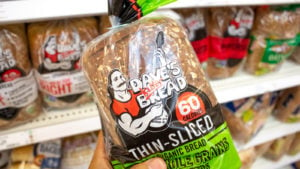We believe that food stocks can be a good place to invest for income. Companies in the food industry perform much better in a recession than other sectors as consumers still need to eat and drink, making food industry companies one of the most resilient groups.
These stocks likely won’t provide extraordinary gains, but they can offer consistent growth and market-beating yields. These types of stocks can also help an investor balance out the more growth orientated portions of their portfolio.
Three of our favorite food stocks ranked in order of expected returns are:
Top Food Stocks: General Mills (GIS)

General Mills has been in business for more than a century and has grown into one of the largest packaged goods companies during that time. The company has a market capitalization approaching $36 billion and annual revenues of $18 billion.
General Mills has a number of category leading brands, including Cheerios, Wheaties, Yoplait, Haagen-Dazs, Annie’s and Bisquick. This gives the company a presence in almost every isle of the grocery store. General Mills also augmented its food business with its acquisition of pet food company Blue Buffalo. More recently, the company added to its pet food portfolio with the purchase of Tyson Foods’ (NYSE: TSN) pet treat segment. We feel that the pet food business could be a real source of strength in the years ahead.
The company has returned to growth over the past few years, driven by the need for at home meals following the onset of the pandemic. General Mills posted some of its highest year-over-year growth rates during this period as consumers prepared more meals at home.
Even with at least a partial reopening in many regions, General Mills continues to perform well as new customers appeared to have turned into repeat customers. Results for the first quarter of fiscal year 2022 were reported on Sept. 22. Revenue grew 4% on top of the 9% increase that occurred in the first quarter of the prior year. Adjusted earnings-per-share did fall slightly, but this was mostly due to raw material costs and supply chain issues.
However, General Mills was fairly successful at passing along at least some of these inflation costs to the consumer. We anticipate that General Mills will be able to grow its earnings-per-share at a rate of 3% annually over the next five years. This is lower then the 10-year average growth rate of 4% as we feel the gains made over the past few years provide a high base from which to grow.
General Mills offers a yield of 3%, which compares very favorably to the average yield of 1.3% for the S&P 500 index. The company paused its dividend for the three years prior to a 4.1% increase last year, but has paid an uninterrupted dividend of almost 120 years.
Using the most recent closing price of $59 and our expectation for earnings-per-share of $3.80 for the fiscal year, General Mills has a price-to-earnings ratio of 15.5. The stock has traded with a multiple of 17 times earnings over the last decade, which is a fair five-year target valuation in our view. If the multiple does expand, shareholders could see a 1.9% tailwind to total returns from valuation.
Added up, we see total returns per year for the next half-decade of 7.9% stemming from a 3% earnings growth rate, starting yield of 3% and a small contribution from multiple expansion.
Flowers Foods (FLO)

Flowers Foods started its business in 1919 and has grown into a leading provider of packaged foods in the U.S. The company has annual revenues of $4.4 billion and a market capitalization of almost $5 billion.
The company’s brands, such as Wonder Bread and Nature’s Own, are well-known and trusted by consumers. The company has two business segments, including direct-to-store-delivery and warehouse delivery. The vast majority of revenues come from product delivery to stores. In addition, 75% of product revenue comes from fresh breads, buns, rolls and tortillas.
Flowers Foods last reported earnings results on Aug. 12. Revenue was lower by 0.8% to $1.02 billion. The decline was due to a tough comparison in the record setting second quarter of 2020, where the company experienced 5% revenue growth as consumers stocked up on products during the pandemic. Adjusted net income fell 1.7% to $68.8 million, a solid result given the comparable period.
The packaged food business is a very competitive space, where switching costs for consumers are on the low end. That said, Flowers Foods’ leadership position and well-known brands does afford it a size and scale that many competitors cannot hope to match. We believe that this will allow Flowers Foods to grow earnings-per-share at a rate of 5% per year through 2026, a more conservative estimate than its 10-year average growth rate of 7%.
Flowers Foods also has a dividend yield of 3.6% at the moment, which is nearly triple that of the S&P 500 index. The company has raised its dividend for 19 consecutive years and has a dividend growth rate of 7% since 2011.
Shares of the company closed Tuesday’s trading session at $23.59. Our expectation is that Flowers Foods will earn $1.20 per share in 2021, implying a price-to-earnings ratio of 19.6. We have a five-year target price-to-earnings ratio of 20, which is below that of the long-term average. An expanding multiple could add 0.4% to returns through 2026.
Combining our expectations for 5% earnings growth, 3.6% dividend yield and a small contribution from valuation expansion results in our expected total return of 9% per year for Flowers Foods.
Top Food Stocks: Mondelez (MDLZ)

Mondelez has a long history of merger and spinoffs and was formerly known as Kraft Foods. The company today is a global food processor giant that generates annual revenues of $26 billion and has a market capitalization of $84 billion.
The company’s portfolio includes snacks, candy and beverages, including Oreo, Nabisco, Trident, Cadbury and Tang. Unlike the other names on this list, Mondelez operates a much more diversified business model. Europe is the company’s number one market and accounts for 38% of annual revenues, with North America adding 31%. Asia, Middle East and Africa and Latin America make up the remaining revenue figures.
We feel that the company’s massive presence in emerging markets will be a long-term winner as these areas are growing faster than the more developed ones. This has played out already over the past few quarters as the economies of the world begin to recovery from the pandemic. A weaker U.S. dollar has also been a tailwind to results, an added bonus considering more than two-thirds of revenues come from outside of the U.S.
Announced on July 27, revenue for the second quarter grew 12.4% to $6.6 billion. Revenue in same period for the prior year fell 2.5%, mostly due to weakness in emerging markets. Adjusted earnings-per-share improved 8.2% as emerging markets bounced back with a nearly 17% improvement in sales. Latin America surged 31% and Asia/Middle East/Africa grew 17.4%. Mondelez showed excellent growth even against a weaker comparable number.
We feel that emerging market gains are sustainable, albeit at a lower rate than what took place in the most recent quarter. We anticipate earnings growth of 8% through 2026, above the five-year growth rate of 6%.
Mondelez’s stock yields 2.4%, the lowest yield of the names in this article, but still a higher level of income than the market index. The company has raised its dividend for the past seven years.
Shares trade near $59. We project that Mondelez will earn $2.85 in 2021, resulting in a price-to-earnings ratio of 20.7. We forecast a five-year target price-to-earnings ratio of 20 for the stock, close to the long-term average. Reverting to this valuation could reduce annual returns by 0.7% through 2026.
Altogether, we forecast annual returns of 9.7% due to an 8% earnings growth rate and 2.4% starting yield marginally offset by a reversion to our expected target valuation.
On the date of publication, Bob Ciura did not have (either directly or indirectly) positions in any of the securities mentioned in this article. The opinions expressed in this article are those of the writer, subject to the InvestorPlace.com Publishing Guidelines.
Bob Ciura has worked at Sure Dividend since 2016. He oversees all content for Sure Dividend and its partner sites. Prior to joining Sure Dividend, Bob was an independent equity analyst. His articles have been published on major financial websites such as The Motley Fool, Seeking Alpha, Business Insider and more. Bob received a bachelor’s degree in Finance from DePaul University and an MBA with a concentration in investments from the University of Notre Dame.
